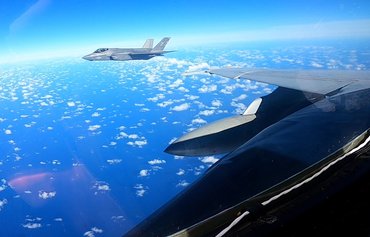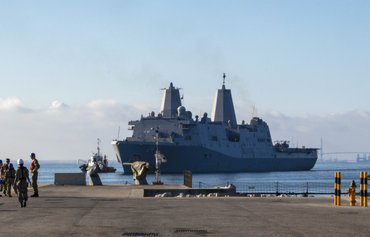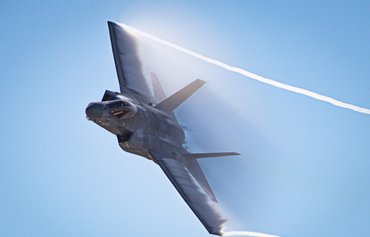After three months at sea crossing the Atlantic, Mediterranean and Black seas on its way to Japan, the United Kingdom's HMS Queen Elizabeth now can reliably deliver both UK and US operational sorties by day and by night.
With anti-air, anti-surface and anti-sub-surface capabilities, and a total of 18 UK and US Marine Corps F-35B aircraft onboard, this is "the largest fifth-generation carrier air wing in the world", according to the Marine Corps.
"We have never seen a ship with 18 F-35s out there that is going to transverse half the world like we're going to do," Lt. Col. Andrew D'Ambrogi of the US Marine Corps told USNI News in April. "It's a pretty bold statement. It's about power projection."
Leading two destroyers, two frigates, a submarine and two support ships, the Queen Elizabeth set sail from Britain in May for a seven-month deployment, and arrived in Japan on September 4.
![HMS Queen Elizabeth leads a flotilla of destroyers and frigates from the United Kingdom, United States and the Netherlands, together with two Royal Fleet Auxiliaries on May 10, 2020. [Royal Navy]](/cnmi_di/images/2021/09/09/31613-hms-frigate-600_384.jpg)
HMS Queen Elizabeth leads a flotilla of destroyers and frigates from the United Kingdom, United States and the Netherlands, together with two Royal Fleet Auxiliaries on May 10, 2020. [Royal Navy]
In a news release in April detailing the deployment, the UK Defence Ministry outlined the opportunities the multi-national carrier strike group will have to drill with other nations and the deployment's focus on the Indo-Pacific region, USNI reported.
"The forthcoming deployment will bolster already deep defence partnerships in the region, where the UK is committed to a more enduring regional defence and security presence," the release said.
"On a 28-week deployment spanning 26,000 nautical miles, the carrier strike group will conduct engagements with Singapore, the Republic of Korea, Japan and India as part of the UK's tilt towards the Indo-Pacific region," it said. "Units from the carrier strike group are expected to visit more than 40 countries and undertake over 70 engagements."
First mission against ISIS
On its way to Japan, the Queen Elizabeth stopped in the Mediterranean, where it engaged with NATO allies and partners and contributed to the United Kingdom's fight against the "Islamic State of Iraq and Syria" (ISIS).
The United Kingdom's Operation Shader forms part of the US-led Global Coalition against ISIS.
As part of its first operational sorties, forces aboard the carrier joined coalition operations to prevent ISIS from regaining a foothold in Iraq and to secure their global defeat.
The carrier strike group also took part in the NATO-led exercise, "Steadfast Defender 2021", held in May-June to improve the allied forces' ability to move quickly and operate together to respond to any threat from any direction, according to NATO.
"HMS Queen Elizabeth's first missions against ISIS will be remembered as a significant moment in the 50-year lifespan of this ship," said Commodore Steve Moorhouse, commander of the carrier strike group, according to a UK government statement.
"It also marks a new phase of our current deployment. To date we have delivered diplomatic influence on behalf of the UK through a series of exercises and engagements with our partners," he said. "Now we are ready to deliver the hard punch of maritime-based air power against a shared enemy."
"The involvement of HMS Queen Elizabeth and her Air Wing in this campaign also sends a wider message. It demonstrates the speed and agility with which a UK-led Carrier Strike Group can inject fifth generation combat power into any operation, anywhere in the world, thereby offering the British Government, and our allies, true military and political choice."
A force to be reckoned with
There are 18 UK and US F-35B jets on board the HMS Queen Elizabeth, which is the largest number ever to sail the seas. The jets are next generation multi-role combat aircraft equipped with advanced sensors, mission systems and stealth technology, according to the UK government.
"With its fifth generation capabilities, including outstanding situational awareness, the F-35B is the ideal aircraft to deliver precision strikes," said Capt. James Blackmore, commander of the Carrier Air Wing, in June.
This was also "the first combat mission flown by US aircraft from a foreign carrier since HMS Victorious in the South Pacific in 1943", he said.
"The level of integration between Royal Navy, Royal Air Force and US Marine Corps is truly seamless, and testament to how close we've become since we first embarked together last October," he added.
The F-35B aircraft, armed with SPEAR-3 underway with Aegis capable cruisers and destroyers, makes the UK carrier strike group one of the most powerful forces globally.
The Selective Precision Effects At Range Capability-3 (SPEAR-3), is a 100-kg missile which is used as the primary air-to-surface weapon for the UK Royal Navy's F-35B Lightning II Joint Strike Fighter, as well as the Royal Air Force's GR4 Typhoon aircraft.
The SPEAR-3 is an aircraft-mounted cruise missile with a range of 140km that can fly at 5m off the ground.
The missile is designed to defeat mobile, relocatable targets, regardless of the weather or time of the day. The tight rules of engagement seek to minimise civilian casualties and damage to non-military targets.
On January 6, Reuters reported that the United Kingdom had signed a $751 million contract with European weapons-maker MBDA to manufacture surface-attack missiles for use on the country's F-35B fighter jets.
Britain said making the SPEAR-3 would enhance the United Kingdom's future combat air capability and support more than 700 jobs in the country.
Because of the short takeoff of the F-35B, the Queen Elizabeth can rapidly launch 20 F-35B aircraft for a quick stealthy strike.
The F-35 can conduct deep stealth penetration missions up to 724km in stealth mode before launching the SPEAR-3. It has been acclaimed as one of the world's most advanced jets, with a top speed of Mach 1.6 (1,975km/h).

![As part of its first operational sorties, forces aboard the HMS Queen Elizabeth joined coalition operations in June to prevent ISIS from regaining a foothold in Iraq and to secure their global defeat. [UK Carrier Strike Group]](/cnmi_di/images/2021/09/09/31612-r08-hms-600_384.jpg)






